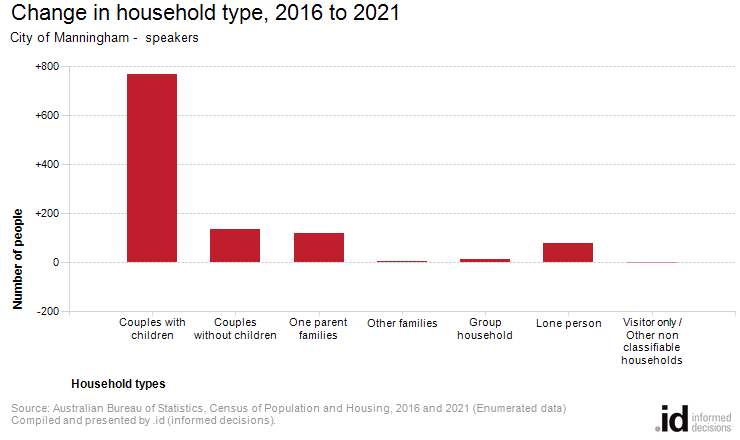City of Manningham
Non-English speakers - Household type
In City of Manningham, 68.0% of [Toggles].[COIIDDisplayLabel] speakers were in couples with children households.
City of Manningham's household and family structure is one of the most important demographic indicators. For the non-English speaking population, only those family members who speak a language other than English at home are counted. Other family members who may speak English at home are not included in the table.
This topic reveals the area's residential role and function for the non-English speaking population and what type of households they are forming. This is likely to be strongly related to Age Structure - while recent migrants are young and likely to form families (and group households in the case of student areas), more established migrant communities may have older families and empty nesters in their mix of households.
To continue building the story of those speaking a language other than English in City of Manningham, please look at this topic in conjunction with Age Structure, Household Size and Number of Bedrooms.
Derived from the Census question:
'What is the person's relationship (to each other person in the household)?'
People speaking [COIIDLabelForLanguage] at home, counted in private dwellings
| Household type | ||||||||
|---|---|---|---|---|---|---|---|---|
| City of Manningham - [Toggles].[COIIDDisplayLabel] | 2021 | 2016 | Change | |||||
| Households by type | Number | % | Greater Melbourne | Number | % | Greater Melbourne | 2016 to 2021 | |
| Couples with children | 2,246 | 68.0 | 64.7 | 1,479 | 67.6 | 63.7 | +767 | 19500 |
| Couples without children | 542 | 16.4 | 14.0 | 408 | 18.6 | 13.4 | +134 | 19501 |
| One parent families | 251 | 7.6 | 10.4 | 131 | 6.0 | 9.7 | +120 | 19502 |
| Other families | 33 | 1.0 | 1.0 | 26 | 1.2 | 1.9 | +7 | 19503 |
| Group household | 54 | 1.6 | 3.4 | 41 | 1.9 | 6.2 | +13 | 19504 |
| Lone person | 168 | 5.1 | 6.1 | 90 | 4.1 | 4.6 | +78 | 19505 |
| Visitor only / Other non classifiable households | 9 | 0.3 | 0.3 | 13 | 0.6 | 0.4 | -4 | 19507 |
| Total persons counted in private dwellings | 3,303 | 100.0 | 100.0 | 2,188 | 100.0 | 100.0 | +1,115 | |
Source: Australian Bureau of Statistics, Census of Population and Housing (opens a new window) 2016 and 2021. Compiled and presented by .id (opens a new window)(informed decisions).

Compiled and presented by .id (informed decisions).

Compiled and presented by .id (informed decisions).
Dominant groups
Analysis of the household/family types of [Toggles].[COIIDDisplayLabel] speakers in City of Manningham in 2021 compared to Greater Melbourne shows that there was a higher proportion of [Toggles].[COIIDDisplayLabel] speakers in couple families with child(ren) as well as a lower proportion in one-parent families. Overall, 68.0% of [Toggles].[COIIDDisplayLabel] speakers were in couple families with child(ren), and 7.6% were one-parent families, compared with 64.7% and 10.4% respectively for Greater Melbourne.
There were a lower proportion of [Toggles].[COIIDDisplayLabel] speakers in lone person households and a higher proportion in couples without children. Overall, the proportion of [Toggles].[COIIDDisplayLabel] speakers in lone person households was 5.1% compared to 6.1% in Greater Melbourne while the proportion in couples without children was 16.4% compared to 14.0% in Greater Melbourne.
Emerging groups
The number of [Toggles].[COIIDDisplayLabel] speakers in households in City of Manningham increased by 1,115 between 2016 and 2021.
The largest changes in the family/household types of [Toggles].[COIIDDisplayLabel] speakers in City of Manningham between 2016 and 2021 were:
- Couples with children (+767 persons)
- Couples without children (+134 persons)
- One parent families (+120 persons)
- Lone person (+78 persons)
